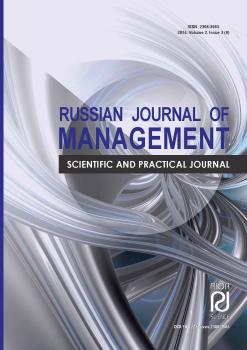Saransk, Saransk, Russian Federation
In the conditions of globalization of social and economic processes, growth of dynamism and uncertainty of factors of environment network interaction of economic agents, especially in the innovative sphere, becomes the important instrument of formation of competitive advantage due to access to various combinations of ideas, advanced knowledge and technologies, unique resources. In this regard in article methodological basics of creation of intercompany networks are covered: the categories opening the maintenance of intersubject networks, dual approach to structural interaction of subjects of innovative activity, theoretical prerequisites of formation of mechanisms of formation of network structures (the theory of information, chaos, synergetrics, nonequilibrium thermodynamics). The practice of network interaction within the portfolios of alliances created by the international companies Sony and Sumsung allowing to reveal features in the organization of intra firm interaction of structural divisions, management of the companies and also in creation of portfolios of alliances is studied. The analysis of various configurations of networks, their advantages and shortcomings is carried out, the factors having impact on success of network interaction of subjects of innovative business, their competitive advantages are established. It is shown that the Russian business still has no understanding of importance of change of organizational forms of both intra firm, and intercompany interaction, wide use of the experience of creation of interindustry and international networks which is saved up by the foreign companies on the basis of strategic partnership and alliances.
innovatively active company, structure, networks, network interaction, dual approach, environment, strategic partnership and alliances, portfolios of alliances, configurations of a network of alliances.
1. Griv G. Preimushchestvo setey: Kak izvlech´ maksimal´nuyu pol´zu iz al´yansov i partnerskikh otnosheniy /Genrikh Griv, Tim Rouli, Andrey Shipilov: Per. s angl.- M.: AL´PINA PABLIShER. 2014. - 259 s.
2. Kostak R.M. Setevye formy organizatsii biznesa kak faktor bor´by s krizisnymi yavleniyami v ekonomike. - URL: hiip://economuch. com/mirovoe-razvitie-lektsii-setevjie-formy:- organizatsii-biznesa - 12055; html.
3. Kouz R. Priroda firmy / Pod red. O.I. Uil´yamsona i S.Dzh. Uintera. - M.: Delo, 2001. - 408 s.
4. Neretina E.A. Tipy, konfiguratsiya i sposoby postroeniya mezhorganizatsionnykh setey. Izvestiya vysshikh uchebnykh zavedeniy. Povolzhskiy region. - 2014. - № 2. - S. 196-204.
5. Ryuegg-Shtyurm Y., Akhtenkhagen L. Setevye organizatsionno-upravlencheskie formy - moda ili neobkhodimost´?. Problemy teorii i praktiki upravleniya. - 2000. - № 6. -S. 68-72.
6. Sheresheva M.Yu. Mezhfirmennye seti. - M.: TEIS, 2006.
7. Sheresheva M.Yu. Formy setevogo vzaimodeystviya kompaniy. Kurs lektsiy: ucheb. posobie. - M.: Vysshaya shkola ekonomiki, 2010. - 339 s.
8. Shtompka P. Sotsiologiya sotsial´nykh izmeneniy / Per. s angl.; pod red. V.A. Yadova. - M., Aspekt-Progress, 1996. - 416 s.
9. Gereffi G., Humphrey J, Sturgeon T. The govermance of global value chains. Review of International Political Economy. - 2005. - Vol. 20. - № 3.
10. Hinterhueber H.H., Levin B.M. Strategic Networks - the Organization of the Future. Long Range Planning. - 1994. - Vol. 27. -I. 3.
11. Meles R.F., Snow C.C. Network Organizations: New Concepts For New Forms. California Management Review. - 1986. - V. 8. - I. 3
12. Riewer K., Klein S., Godolin M. Network Business Model Configuration - New Roles for Dynamic Network Arrangements. Challenges and Achievements in E-Business and E-Work/ed by B. Stanford - Smish, E.Chiozza. M.Edin. Part 2, Amsterdam: IOS Press, 2002. P. 892-899.














